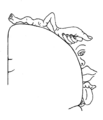Touch facts for kids
- This article is about one of the five main senses. For other uses, see Touch (disambiguation)
Touch is one of the five main senses that animals have. It helps us know if something is against our body. We often call this "feeling" something.
Your body has tiny sense organs under your skin. These help you feel if something is hard, soft, or sharp. They also help you feel temperature (hot or cold) and pain. Some parts of your body, like your fingertips, have many more of these sense organs than others. This is why your fingertips are very sensitive!
When you touch something, special nerve fibres connected to these sense organs send messages. These messages travel through your central nervous system to your brain. A special area in your brain, in the parietal lobe, then understands these messages. This is how you "feel" what you are touching.
Contents
How Touch Works
Your skin is covered with millions of tiny sensors. These sensors are called receptors. They are like tiny detectors for different feelings. Some receptors feel pressure, others feel temperature, and some feel pain.
When you touch something, these receptors send signals. These signals travel along nerves, which are like tiny wires. The nerves carry the signals to your spinal cord, and then up to your brain. Your brain then figures out what you are touching.
Types of Touch Receptors
There are different kinds of touch receptors, each designed for a specific job:
- Pressure receptors: These help you feel how hard something is pressing on your skin. They let you know if a hug is gentle or a squeeze is tight.
- Temperature receptors: These tell your brain if something is hot or cold. They protect you from extreme temperatures.
- Pain receptors: These are very important for your safety. They warn you about things that might hurt your body, like a sharp object or something too hot.
- Vibration receptors: These help you feel things that are moving quickly back and forth, like a buzzing phone.
Touch as Communication
Humans and other mammals often touch each other. This is a way of non-verbal communication. It means you can send messages without using words.
Touching is very important for keeping family and group members close. This is called 'bonding'. It helps create strong connections between individuals. For example, Monkeys often grooming each other's fur. This is not just about cleaning; it's a way they show care and strengthen their group ties.
Related pages
| Sensory system |
|---|
| Hearing • Sight • Touch • Taste • Smell • Proprioception |
Images for kids
-
Touch can make us feel many things! Here, a baby laughs at being tickled by an older sister.
-
The cortical homunculus is a map of the brain's touch areas, created by Wilder Penfield.
See also
 In Spanish: Sistema somatosensorial para niños
In Spanish: Sistema somatosensorial para niños




